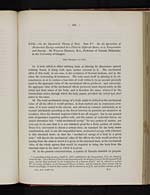Lord Kelvin (1824-1907)
On the dynamical theory of heat. Part 5. On the quantities of mechanical energy contained in a fluid in different states, as to temperature and density
( 475 )
XXXI.—On the Dynamical Theory of Heat. Part V.* On the Quantities of
Mechanical Energy contained in a Fluid in Different States, as to Temperature
and Density. By WILLIAM THOMSON, M.A., Professor of Natural Philosophy
in the University of Glasgow.
(Read December 15, 1851.)
81. A body which is either emitting heat, or altering its dimensions against
resisting forces, is doing work upon matter external to it. The mechanical
effect of this work, in one case, is the excitation of thermal motions, and in the
other, the overcoming of resistances. The body must itself be altering in its cir-
cumstances, so as to contain a less store of work within it, by an amount precisely
equal to the aggregate value of the mechanical effects produced: and conversely,
the aggregate value of the mechanical effects produced, must depend solely on the
initial and final states of the body, and is therefore the same, whatever be the
intermediate states through which the body passes, provided the initial and final
states be the same.
82. The total mechanical energy of a body might be defined as the mechanical
value of all the effect it would produce, in heat emitted and in resistances over-
come, if it were cooled to the utmost, and allowed to contract indefinitely or to
expand indefinitely according as the forces between its particles are attractive or
repulsive, when the thermal motions within it are all stopped; but in our present
state of ignorance regarding perfect cold, and the nature of molecular forces, we
cannot determine this “total mechanical energy” for any portion of matter, nor
even can we be sure that it is not infinitely great for a finite portion of matter.
Hence it is convenient to choose a certain state, as standard for the body under
consideration, and, to use the unqualified term, mechanical energy, with reference
to this standard state; so that the “ mechanical energy of a body in a given
state,” will denote the mechanical value of the effects the body would produce in
passing from the state in which it is given, to the standard state, or the mechanical
value of the whole agency that would be required to bring the body from the
standard state to the state in which it is given.
83. In the present communication, a system of formulæ founded on proposi-
* A preceding communication (April 21, 1851) published, in the Transactions (Vol. xx., Part ii.),
under the title,“On a Method, of Discovering Experimentally the Relation between the Mechanical Work
spent, and. the Heat produced, by the Compression of a Gaseous Fluid,” will be referred to as Part
IV. of a series of Papers on the Dynamical Theory of Heat; and the numbers of its sections will be
altered accordingly, so that its first section will be referred to as § 61, and its 20th and last, as § 80.
VOL.XX.PART III.
6 M


